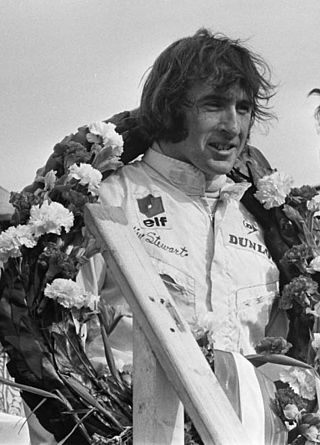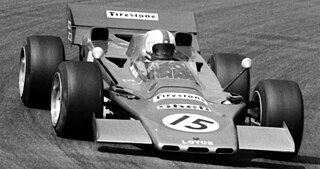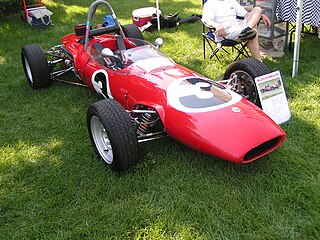Related Research Articles

Lotus Group is a British multinational automotive manufacturer of luxury sports cars and electric vehicles.

James "Jim" Clark was a British racing driver from Scotland, who competed in Formula One from 1960 to 1968. Clark won two Formula One World Drivers' Championship titles with Lotus, and—at the time of his death—held the records for most wins (25), pole positions (33), and fastest laps (28), among others. In American open-wheel racing, Clark won the Indianapolis 500 in 1965 with Lotus, becoming the first non-American winner of the race in 49 years.

Anthony Colin Bruce Chapman was an English design engineer, inventor, and builder in the automotive industry, and founder of the sports car company Lotus Cars.

The Lotus Europa name is used on two distinct mid-engine GT cars built by British automobile manufacturer Lotus Cars. The original Europa and its variants comprise the Lotus Types 46, 47, 54, 65 and 74, and were produced between 1966 and 1975.

Brands Hatch is a motor racing circuit in West Kingsdown, Kent, England, United Kingdom. Originally used as a grasstrack motorcycle circuit on farmland, it hosted 12 runnings of the British Grand Prix between 1964 and 1986 and currently hosts many British and International racing events. The venue is owned and operated by Jonathan Palmer's MotorSport Vision organisation.

The 1968 Spanish Grand Prix was a Formula One motor race held at Jarama Circuit on 12 May 1968. It was race 2 of 12 in both the 1968 World Championship of Drivers and the 1968 International Cup for Formula One Manufacturers. It was the first race after the death of former double World Champion Jim Clark, who had died in a non-championship Formula Two event in Hockenheim, Germany the previous month. Clark had led the drivers' championship before this race, on 9 points, after he won in the first race in South Africa.

The 1970 Dutch Grand Prix was a Formula One motor race held at Zandvoort on June 21, 1970. It was race 5 of 13 in both the 1970 World Championship of Drivers and the 1970 International Cup for Formula One Manufacturers. This race was held the same day as the 1970 FIFA World Cup Final in Mexico City, Mexico, but that event took place later in the day from this Grand Prix.

The 1969 Formula One season was the 23rd season of the FIA's Formula One motor racing. It featured the 20th World Championship of Drivers, the 12th International Cup for F1 Manufacturers and four non-championship races open to Formula One cars. The World Championship was contested over eleven races between 1 March and 19 October 1969.

The 1961 Formula One season was the 15th season of FIA Formula One motor racing. It featured the 12th World Championship of Drivers, the 4th International Cup for F1 Manufacturers, and numerous non-championship Formula One races. The World Championship was contested over eight races between 14 May and 8 October 1961.

Alan Stacey was a British racing driver. He began his association with Lotus when he built one of the MkVI kits then being offered by the company. Having raced this car he went on to build an Eleven, eventually campaigning it at Le Mans under the Team Lotus umbrella. During the following years he spent much time developing the Lotus Grand Prix cars, most notably the front-engined 16 and then the 18. He participated in seven Formula One World Championship Grands Prix, debuting on 19 July 1958. He scored no championship points. He also participated in several non-championship Formula One races.

Team Lotus was the motorsport sister company of English sports car manufacturer Lotus Cars. The team ran cars in many motorsport categories including Formula One, Formula Two, Formula Ford, Formula Junior, IndyCar, and sports car racing. More than ten years after its last race, Team Lotus remained one of the most successful racing teams of all time, winning seven Formula One Constructors' titles, six Drivers' Championships, and the Indianapolis 500 in the United States between 1962 and 1978. Under the direction of founder and chief designer Colin Chapman, Lotus was responsible for many innovative and experimental developments in critical motorsport, in both technical and commercial arenas.

David Walker was an Australian racing driver who drove for Lotus in the 1971 and 1972 Formula One World Championships.

The Lotus 49 was a Formula One racing car designed by Colin Chapman and Maurice Philippe for the 1967 F1 season. It was designed around the Cosworth DFV engine that would power most of the Formula One grid through the 1970s. It was one of the first F1 cars to use a stressed member engine combined with a monocoque to reduce weight, with other teams adopting the concept after its success. An iteration of it, the 49B, also pioneered the use of aerofoils to generate downforce.
Formula One sponsorship liveries have been used since the 1968 season. Before the arrival of sponsorship liveries in 1968 the nationality of the team determined the colour of a car entered by the team, e.g. cars entered by Italian teams were rosso corsa red, cars entered by French teams were bleu de France blue, and cars entered by British teams were British racing green. Major sponsors such as BP, Shell, and Firestone had pulled out of the sport ahead of this season, prompting the Fédération Internationale de l'Automobile to allow unrestricted sponsorship.

The Lotus 51 was an open-wheel Formula Ford race car built in 1967 by the British motorsport team Lotus. It was powered by a 1.6 L (98 cu in) Ford Crossflow four-cylinder engine, developing a respectable 110 hp (82 kW), which drove the rear wheels through either a Renault R-8 type 330 4-speed, or a Hewland 5-speed manual transmission.
The 1985 British Formula Three Championship was the 35th season of the British Formula Three Championship. Maurício Gugelmin took the BARC/BRDC Marlboro British Formula 3 Championship.
Geoff Ferris is a British racing car designer who has designed open-wheel racing cars for Penske Racing, Lotus, Rebaque and Brabham.
The March 693 was a Formula 3 racing car built and used by March Engineering in 1969. It was powered by a naturally aspirated, 997 cc, Ford 105E straight-four engine, producing 120 hp (89 kW), and weighing in at a tiny 400 kg (880 lb).
The Cooper T83 is an open-wheel formula racing car, designed, developed and built by British manufacturer Cooper, for Formula 3 categories, in 1966. It was an evolution of the previous T76. It was powered by a 998 cc (60.9 cu in) BMC four-cylinder engine, developing 88 hp (66 kW) @ 7,750 rpm, which had a 12.5:1 compression ratio. The chassis used was a tubular space frame, while the body was constructed as a semi-stressed skin. The front suspension was altered to widen the front track and minimise the leverage rate of the front shock absorbers. The rear suspension was also totally reworked, to equal the symmetry of the T81 Formula One car. The car was not successful. It suffered severe understeer, due to the undertray of the car being "flat-bottomed" in design, almost creating aerodynamic vortices under the car, and affecting its ground effect properties. Only 7 models were produced. A developmental version of the car used a larger Cosworth SCB Formula Two engine. It entered more than 5 races, and claimed one pole position, but didn't finish that particular race; with the wheel coming off, and achieved no further success after that.
The Cooper T85 was an open-wheel formula racing car, designed, developed and built by British manufacturer Cooper, for Formula Three racing categories, in 1967. It was their 16th and final Formula 3 car. It was powered by a 998 cc (60.9 cu in) BMC four-cylinder engine, developing around 88 hp (66 kW) @ 7,750 rpm, and had a 12.5:1 compression ratio. Only two models were produced. It used inboard front suspension, and was very similar in design to its predecessor. It is known to have entered one race at Brands Hatch in 1967, being driven by Les Leston, but did not end up finish the race. A Ford-powered version of the car entered a second race at Montlhéry in 1968, also without any success.
References
- ↑ "Lotus – F3History". f3history.co.uk. Retrieved 2024-09-19.
- ↑ "Lotus Models". lotusespritturbo.com. Retrieved 2024-09-19.
- ↑ "Lotus Europa First 100 Cars". lotus-europa.com. Retrieved 2024-09-19.